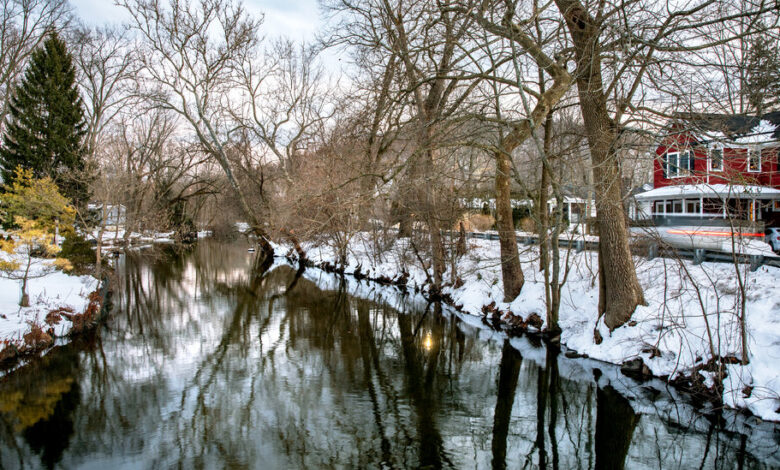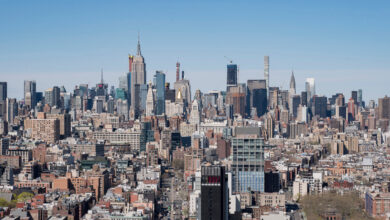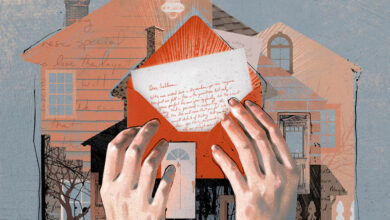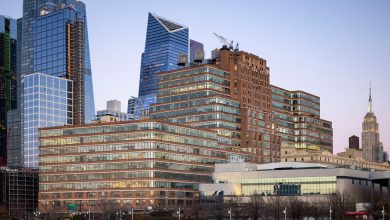Oakland, N.J.: A Rustic Version of Suburbia, 30 Miles From Midtown

[ad_1]
On the first night in their new home in Oakland, in northern New Jersey, the Kumar family watched deer cross their backyard, leaving paw prints in the snow. Prem Kumar said it was the first time he had ever seen deer outside of a petting zoo. He knew he wasn’t in Queens anymore.
“It’s a readjustment, but nothing we’re not happy about,” Mr. Kumar, 35, a civil engineer, said of the move to the wide-open borough of 13,000 in westernmost Bergen County.
He and his wife, Mandeep, 25, and their two daughters had been living with his parents in the house where he grew up, in Jamaica. The desire for more space for everyone, plus Mr. Kumar’s pending job change, kicked off a home search in the northern and western suburbs. The couple’s major criteria were good schools and relative affordability.
Late last year, around the time he landed a new position in Nanuet, N.Y., in Rockland County, Mr. Kumar and his family became smitten with a rebuilt, nearly 4,000-square-foot, four-bedroom colonial on two-thirds of an acre in Oakland, a 25-minute drive from Nanuet. The couple paid $745,000 for the house, which has mountain views and is more than twice as large as the one they left behind.
The small-town responsiveness eased their transition from the city, Mr. Kumar said. First, the public works department assured the family that their street would be plowed on their snowy December moving day. “And the school district held our hands during the registration of our older daughter,” Mr. Kumar said.
Tucked in a valley next to the Ramapo Mountains and bisected by the Ramapo River, Oakland serves up a rustic version of suburbia 30 miles from Midtown Manhattan. Less pricey than other towns in Bergen County’s affluent northwest, Oakland differs in other ways, too.
In the absence of sewers, 90 percent of the homes have septic systems. The borough’s nine square miles include a state forest and lakes, one with a beach. Many mailboxes are curbside. And in a place where black-bear sightings are posted on Facebook, it’s not just deer that are out wandering.
“My friends from the city say we live in the wild,” said Lauren D’Amato, a Queens native and former Manhattanite. “It is a culture shock. When you sit in the backyard at the end of the day, you can hear yourself think. The town feels secluded, but the highways make it accessible.”
Ms. D’Amato, 40, a clinical director at a behavioral-health company, and her husband, Joe D’Amato, 37, an engineer, bought their five-bedroom colonial, built in the 1960s on half an acre, in 2016, paying $679,000. The couple, who have two young daughters, moved from a smaller Cape Cod-style house in neighboring Wayne, a sprawling township with four times the population. “We got more space and a closer-knit community,” Ms. D’Amato said.
While the elbow room is enticing, Linda H. Schwager, Oakland’s mayor since 2012 and a native New Yorker, sees a more powerful lure. “This is just a great place to bring up children,” she said, adding that families tend to expand their homes or trade up within the borough rather than leave town.
What You’ll Find
Oakland sits on the edge of the New Jersey Highlands, at the confluence of Interstate 287 and Route 208, putting Rockland County, the George Washington Bridge and the corporate campuses of Morris County all within a 30-minute drive.
The principal thoroughfare, Ramapo Valley Road, runs parallel to the river and is lined with small businesses and strip malls, the largest of which, Copper Tree Shopping Plaza, is known regionally for its motor-vehicle office.
Ranches, colonials and split-levels on lots of at least a quarter of an acre are prevalent in the mostly single-family housing stock. Some neighborhoods are defined by their street names, with streets named for colleges popular with young families.
“People buy the ranches there and blow them up into center-hall colonials,” said Chopper Russo, broker associate at Re/Max Traditions Real Estate, in Oakland. “The roads in the college area are level and the houses are closer together — it’s where everyone in town goes trick-or-treating.”
Fewer trick-or-treaters hit the upscale Ramapo River Reserve, a 400-home, two-decade-old enclave in the mountain foothills. In January, Nicole and Jonathan Groat paid $590,000 for a three-bedroom, two-and-a-half-bathroom colonial there, moving a mile from the expanded ranch house they bought three years earlier for $515,000.
Dr. Groat, 31, an audiologist, and Mr. Groat, 32, who works in military defense, wanted to put down roots in Oakland, but preferred a house where all the bedrooms were on one level, for when they have a second child. “Technically, we got a larger house needing updating and a smaller lot — everyone thinks we’re nuts,” Dr. Groat said, noting that their new address comes with snow and leaf removal, and pool access through the development’s community fee.
What You’ll Pay
Oakland is on the radar of first-time buyers as well as those with million-dollar budgets. “People who want to be here can get a house for $250,000” — albeit one in a Ramapo River flood zone — said Michelina Belfiore, the broker-owner of the local Re/Max Traditions agency. “You can get a great Cape Cod for $350,000, $375,000. Or a ranch in the woods for $700,000. There’s a variety of houses and prices to fit different needs of different buyers.”
The median price for a single-family house in the pandemic year of 2020 was $472,500, based on 182 closings, according to the New Jersey Multiple Listing Service. A year earlier, 165 houses sold at a median of $440,000.
On Feb. 25, the service’s website listed 23 single-family houses for sale, from $235,000 to $1.05 million. The high end was dominated by homes in the Ramapo River Reserve, including a four-bedroom, four-and-a-half-bath colonial on Overlook Ridge, with annual property taxes of $25,904 and an asking price of $999,999. Near the median was a three-bedroom, two-bathroom ranch on Nokomis Avenue in a lake community, with an asking price of $439,900 and taxes of $8,364.
The Vibe
Oakland’s youth and adult athletic offerings are eclectic by suburban standards — lacrosse and roller hockey, mountain biking and cheerleading — and a 20-acre recreation complex houses many programs. Community organizations, including long-established Mothers’ and Fathers’ Clubs, support youth activities while fueling a robust volunteer network.
“There are a lot of civic-minded people here — and they get involved,” said Ryan Schwertfeger, 26, who heads the borough’s volunteer communications commission.
For his middle-school service requirement 12 years ago, Mr. Schwertfeger presented the governing council with a petition calling for the creation of a dog run. Eventually tasked with the project’s fund-raising, he brought in $45,000 in cash and more than that in donation of services. On Mother’s Day, a dog run named for Mr. Schwertfeger’s late mother is scheduled to open in a borough park.
The Schools
Oakland has three public elementary schools and a middle school for students in sixth through eighth grade. The 1,325-student district is roughly 82 percent white, 9 percent Hispanic, 3 percent Asian and 1 percent Black.
For ninth through 12th grade, students can choose between Indian Hills High School on Yawpo Avenue, which has an enrollment of 950, and Ramapo High School in Franklin Lakes, which enrolls 1,200. Both are operated by a regional district serving Oakland, Franklin Lakes and Wyckoff. The schools’ honors-level college preparatory programs differ: Business, science and medicine are offered at Indian Hills; engineering and design at Ramapo.
In 2018-19, the average SAT scores at Indian Hills High School were 587 in reading and writing and 574 in math, versus 539 and 541 statewide; at Ramapo, the average scores were 587 and 586.
The Commute
Coach USA offers rush-hour bus service to Port Authority in Manhattan. The ride takes a little over an hour; the 10-trip fare is $75.20, and the 40-trip fare is $258.
Rail commuters can use several New Jersey Transit stations within a 20-minute drive, including the Route 17 Station in Ramsey. From there, the trip to Penn Station in Manhattan takes about an hour and costs $12.25 one way or $353 monthly.
The History
The New Jersey Midland Railway’s arrival in 1869 sparked Oakland’s commercial development and the construction of summer homes. “The truly pristine waters of the Ramapo River and the many freshwater springs of Oakland, coupled with the pure mountain air, perfectly fit the needs of many wealthy New Yorkers,” Kevin Heffernan wrote in “A History of Oakland.” The borough was incorporated in 1902, with the name Oakland winning out over Scrub Oaks, Oakdale, Brae Cliff and Pleasant Valley.
For weekly email updates on residential real estate news, sign up here. Follow us on Twitter: @nytrealestate.
[ad_2]
Source link






